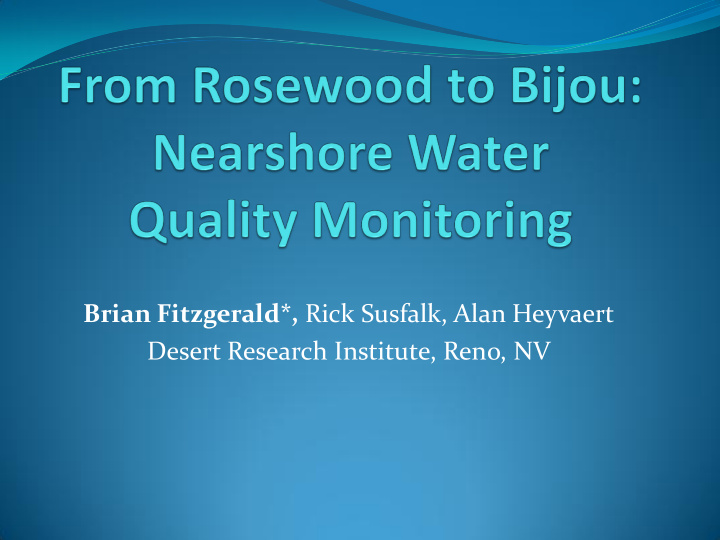



Brian Fitzgerald*, Rick Susfalk, Alan Heyvaert Desert Research Institute, Reno, NV
Outline Summary of Five Projects. Nearshore water quality measurements 2000-2012. South Lake nearshore investigation: on-shore to nearshore. Rosewood Creek Monitoring 2002-2012. Nearshore water quality monitoring buoys, in 2008 and 2010-2011. Nearshore water quality spatio-temporal compilation. Conclusions Future Work
Nearshore Summary The nearshore environment provides habitat for aquatic species and is the area where most visitors and residents directly interact with the lake. Challenges to the quality of the nearshore have increased over time, but their impacts have not been routinely assessed because of the lack of a consistent monitoring program capable of determining meaningful long-term changes. Most material entering the lake passes through the nearshore zone. Therefore, the nearshore is the first location to respond to management actions, allowing early determination of their effectiveness.
Nearshore water quality measurements 2000-2012. Previous work used inverse distance weighted points from a single transect/loop. These studies gave a snapshot of one particular point in time. Threshold development requires compiling all previous circumnavigations.
Influence of Urban Runoff on Nearshore Water Quality at Lake Tahoe, 2007-2009.
South Lake event-based loadings (kg day -1 )
Canoe-based sampling, South Lake Tahoe, 2009-2010 Ultra-nearshore water clarity sampling in water less than 3 feet deep. Early season runoff affects lower watersheds.
Canoe-based sampling, South Lake Tahoe, 2009-2010 Late season runoff affects higher watersheds.
Rosewood Creek Monitoring, 2002-2012 The Lower Rosewood Creek Restoration Project was constructed during spring and summer 2003 to improve the quality of water discharged by the creek. Restored a historical stream environmental zone to more native conditions, increasing the overall length of Rosewood Creek by approximately 975 linear meters The overall objectives were to quantify the magnitude of suspended sediment delivery by Rosewood Creek into Third Creek, and evaluate the efficacy to alter the quantity (mass) and composition (particle-size) of suspended sediment delivered by Rosewood Creek into Third Creek.
Nearshore water quality monitoring buoy in 2008. The objectives of this pilot project were: 1) to test the feasibility and cost-effectiveness of continuously monitoring nearshore water quality, and 2) to determine the best operational protocols. This work can form the basis of a long term monitoring network.
Nearshore water quality monitoring buoy in 2008. The buoy was deployed 40 m from the mouth of Third Creek in Incline Village, NV. Light blue is Incline Creek, green is Third Creek, dark blue is Rosewood Creek, the red dot is the location of the buoy off Third Creek. Instruments were mounted on a buoy providing continuous clarity readings for 7 months in 2008.
Nearshore water quality monitoring buoy in 2008.
Nearshore water quality monitoring buoy in 2008.
Nearshore water quality monitoring buoy in 2008. Biofouling of sensors occurred primarily during summer and early fall, but was minimized by an integrated wiping system. Turbidity was not sensitive during background conditions when water clarity was good (<2 NTU). Light transmissivity measures both light scattering and absorption and was more sensitive under background conditions. Nearshore water clarity became significantly degraded at times. At its highest, turbidity measured at the buoy was 31% of that measured in either of the out-fall creeks indicating at least a three-to-one dilution.
Nearshore water quality monitoring buoy, 2010-2011 Marla bay was chosen as the deployment location for a of the monitoring buoy to examine it’s capability for year-round functionality. Coincided with removal of asian clam tarps.
Nearshore water quality monitoring buoy, 2010-2011 In the first week of November 2010, the UCD TERC team removed a tarp from the substrate designed to inhibit Asian clam growth (Wittman et al, pending). The buoy was placed at the anchor closest to the tarp removal area at the beginning of the fourth deployment on November 1, 2010. The buoy was approximately 200 meters away from the tarps at this time.
Whole-lake Nearshore water quality measurements In-lake turbidity measurements are collected at a resolution of every 2 seconds using a DRI boat specifically built for year-around research of Lake Tahoe’s shallow nearshore zone. The U.S. Forest Service, through the SNPLMA program, has funded a Directed Action to assess current nearshore management, to create a Lake Tahoe nearshore science bibliography, to suggest scientifically-supportable standards and indicators, to develop a nearshore conceptual model, and to suggest a future monitoring plan.
Conclusions The nearshore zone is a conduit for constituents of concern to water clarity; on-shore to mid-lake. The Nearshore Science Team is developing suggested new metrics for water quality indicators. DRI is well-situated to investigate and monitor nearshore water clarity parameters. A long-term spatio-temporal investigation may provide the basis for revamped water quality thresholds for the nearshore zone of Lake.
Future Work Develop threshold indicators, objectives, and metrics for certain water quality parameters. Potentially develop certain zones of influence, with differing exceedance curves and durations. Create maps that include all collected water clarity data to date. Continue collecting whole-lake nearshore data for water clarity parameters.
Questions? Funding: NV DEP, USFS, NTCD, NV State Lands LTLP. Contributors: R. Susfalk, A. Heyvaert, K. Taylor, T. Mihevc, L. Bugenig, M. Shanafield, C. Morton.
Recommend
More recommend